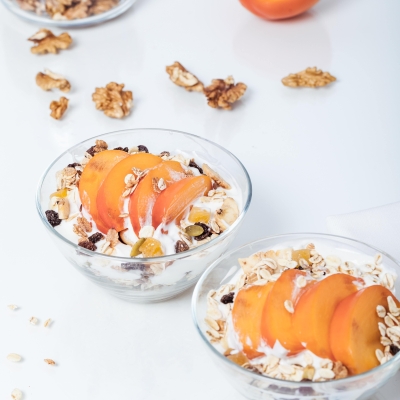Friday, 18 October 2019 / Topics:

Hands up if you ever feel bloated, constipated or just feel like things aren’t as regular as they perhaps should be. While there are a range of things that can cause digestive problems, including underlying medical issues, changing up your diet could help get things moving and boosting your fibre intake is a good starting point.
So, what exactly is fibre? Fibre is a type of carbohydrate that the body can’t digest, meaning what goes in one end comes straight out the other (well… there’s a little more to it than that). There are three types of fibre – soluble fibre, insoluble fibre and resistant starch and each have different, but equally important, roles in our bodies.
Soluble fibre, found in foods such as the flesh of fruits and vegetables, oats, legumes and barley, dissolves in water and forms a thick gel that helps ensure things slide easily through the digestive tract. On the other hand, insoluble fibre, as the name suggests, does not dissolve and instead adds bulk to the stool helping to prevent constipation. Insoluble fibre is found in foods such as the skins of fruits and vegetables, whole grain breads and cereals and nuts and seeds. Last but by no means least is resistant starch. Given the name resistant starch because it ‘resists’ digestion, this type of starch passes through to the large intestine and acts as a food source for all the good bacteria in the gut which promotes good gut health. Resistant starch is found naturally in some foods such as unripe bananas and legumes, but can also be found in certain starchy foods, such as rice, pasta and potatoes, that have been cooked and then cooled. The cooking and cooling process changes the structure of the starch, making it more resistant to digestion.
How much fibre should you be eating each day? Well, the good news is Australia eats more fibre than many other Western countries. The bad news is we’re still not consuming enough. Current recommendations suggest that adults should aim for 25-30 grams of fibre per day consisting of a combination of soluble fibre, insoluble fibre and resistant starch. For example, 30 grams of fibre might look like:
Breakfast: ½ cup of oats with a piece of fruit and 30g almonds
Lunch: 1 whole grain salad sandwich
Dinner: 1 cup of brown rice with 2 cups roasted vegetables
So… how can you increase the amount of fibre in your diet?
Go for 2 & 5
The easiest way to make sure you’re getting enough fibre in your diet is to make sure your eating a variety of fruits and vegetables each day. Eating two serves of fruit and five serves of veg each day will have you well on your way to meeting your daily fibre requirements. Instead of making the meat the highlight of your meal, flip it around and make vegetables the star of your plate. Enhance the flavour of your veg by adding different herbs and spices – think roast vegetables with rosemary and thyme, tomatoes with basil or stirfried greens with garlic and chilli. Don’t forget to keep the skins on your veg for all the valuable insoluble fibre and other beneficial nutrients!
Increase your intake of legumes
When it comes to fibre, legumes really are the whole package. Legumes, including lentils, chickpeas, beans and peas, contain all three types of fibre and one cup of these gut-loving superfoods will provide you with around one third of your daily fibre requirements. Impressive, right! Not sure how to include more legumes into your diet? Start by adding them to the foods you already eat. Having a salad for lunch? Add some canned chickpeas or bean mix. Making a pot of soup for dinner? Beans or lentils are the perfect addition! Tacos on the menu? Replace half of the mince for red kidney beans.
Water
Fibre without water is like a car without wheels. One just simply can’t do its job without the other! Water is necessary to help the fibre move throughout the digestive system. If you’re eating plenty of fibre but not drinking enough water, fibre can actually have the opposite effect causing your stools to become hard and dry. This can increase the chances of it getting “stuck” in the digestive tract, leading to constipation, bloating and gas. To ensure you’re staying properly hydrated, make sure to aim for at least 6-8 glasses of water each day and more during the warmer months.
Switch to wholegrains
Swapping your refined carbohydrates to whole grain alternatives can have a huge impact on your fibre intake. Refined carbohydrates such as white bread, white flour and white rice have been stripped of their outer fibrous layers and hence their valuable fibre content. To put it into perspective, one slice of white bread has around 1.5 grams of fibre whereas one slice of whole grain bread contains 5 grams of fibre. This means that consuming two slices of whole grain bread each day can have you meeting around one third of your daily requirements plus loads more nutrients!
A question we commonly get asked is ‘what about high fibre white bread?’ Essentially, high fibre white breads have had the insoluble fibre taken out of them and then a different type of fibre put back in. Although high fibre white bread and whole grain bread have a similar fibre content, whole grain bread is still the number one choice as it contains the nutrients from the outer layers of the wheat grain including B vitamins and minerals. However, if you just can’t bring yourself to make the switch from white bread, then high fibre white is your next best choice.
Start slowly
If you’re currently not getting enough fibre, make sure to increase your intake slowly over a few days as a sudden increase may cause gas, bloating or any of those unfavorable symptoms that you’re trying to avoid.
Remember, while some bloating is 100% normal, if you’re experience any bloating that is new, consistent or painful, it might be worthwhile checking in with a dietitian to assess what else might be contributing.

